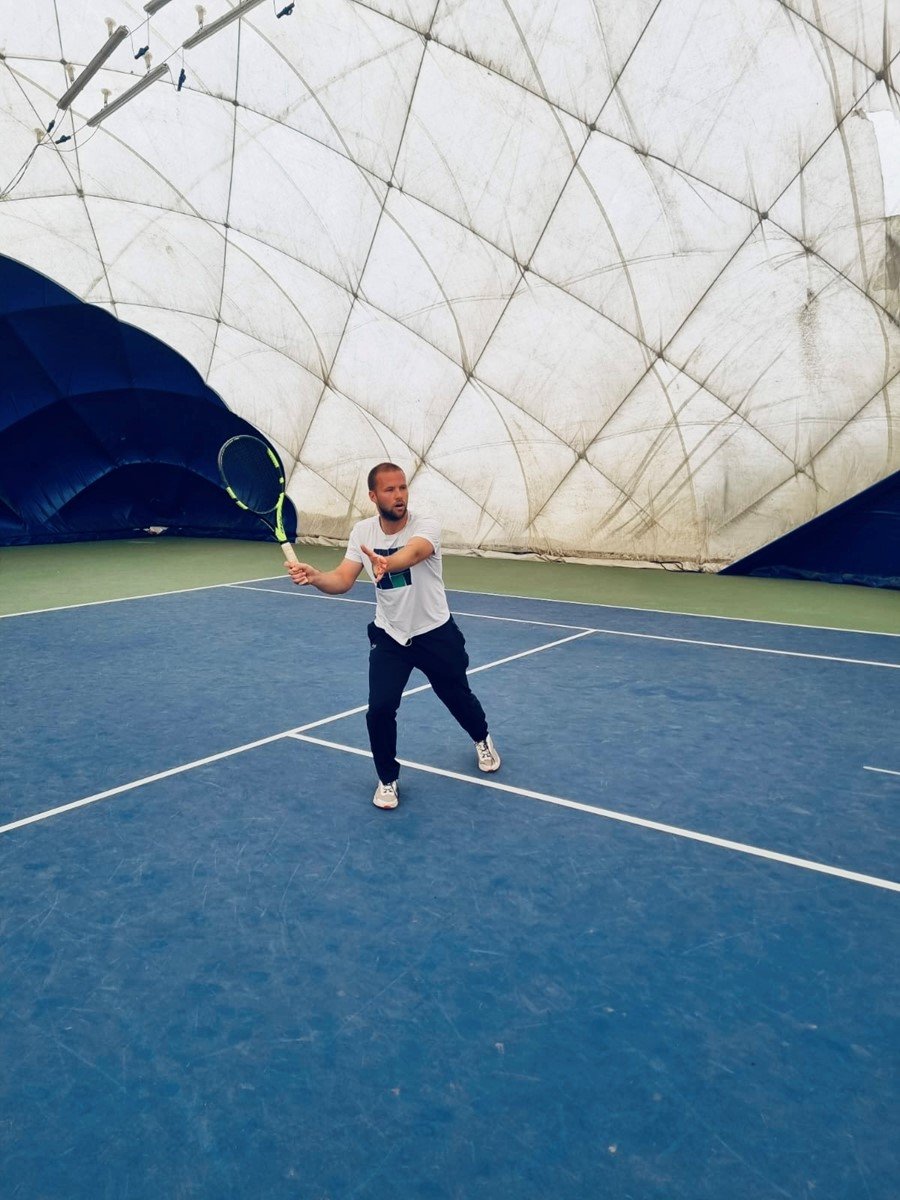In tennis, a drop shot is a finesse shot, used strategically to give your opponent less time to react and get to the ball. It is usually hit in disguise to wrong-foot an opponent. It is not a shot that naturally comes to all players as most players learn to hit the ball and when attacking the ball usually hit it hard to try and beat the opponent.
In this article, we will explore what a drop shot is, when to use it, how to defend against it, and more. Whether you’re a beginner or a seasoned pro, read on to discover everything you need to know about this tricky shot in tennis.

What is a Drop Shot in Tennis?
A drop shot is a technique used to hit the ball lightly over the net, normally with little or no spin, and just enough force to get the ball to bounce low and stop abruptly near the net on the opponent’s side of the court. The objective is to make your opponent think you’re hitting a regular shot while forcing them to scramble to the front of the court, giving you an opportunity to win the point with ease.
Whilst not a new shot in tennis, it has definitely become more regularly used in recent years in the professional game. Watch Jimmy Connors or Chris Evert back in the 70s and you would hardly ever see a drop shot played in a rally. Now watch Djokovic, Alcaraz or Swietek play a match and the drop shot is a major part of a player’s armory and used many times during a set of tennis.
I actually believe that Carlos Alcaraz has taken the drop shot to a new level since he burst onto the tour. He uses it with such disguise and combines it with hard-hitting and then deft touches. His opponents really struggle with this combination. Watch the video below where he gives a masterclass in hitting drop shots in a match. Note how far back Medvedev is on many of these points and he doesn’t even run for them as the drop shots are so good!
Top Tips For Hitting a Drop Shot
Grip
The Continental grip is used for hitting a drop shot due to its versatility and control. This grip allows for a greater range of wrist movement facilitating the delicate touch necessary for the execution of a precise, deceptive drop shot.
It allows players to subtly adjust the angle of the racket face right before contact for optimal placement and spin. Furthermore, the Continental grip is also the grip used for volleys and serves, thus making it easier to disguise the drop shot in a rally.
Backswing
For the backswing, it is essential to maintain a compact and short swing or the ball will fly everywhere. Mimic the swing you would use for a slice shot, as this allows for better control and precision. The swing should be more of a caress, focusing on touch and feel rather than power. It’s important to use the pace of the incoming ball to your advantage. Instead of generating your own power, redirect the existing pace of the ball for your drop shot. This will enhance the disguise and maintain the necessary delicacy of the shot.
Racket Face
The racket face plays a significant role in dictating the direction, spin, and speed of the ball. For a drop shot, it is advisable to slightly open the racket face. While some players might prefer a more open face, it’s generally effective to try and keep the racket face as flat as possible. This helps in ensuring the ball’s trajectory is low and short, which is ideal for a well-executed drop shot. Remember, the aim is to impart backspin and to make the ball die immediately after crossing the net. The flat racket face aids in achieving this desired effect.
Hit The Ball on the Up
Avoid hitting the ball at its lowest point, as it makes it challenging to lift it over the net. A technique adopted by Novak Djokovic is to strike the ball at the top of the bounce, essentially when the ball is on its way up. This particular method provides a greater margin for error, improving the chances of successfully landing the drop shot. It allows the player to inject just the right amount of lift to ensure the ball goes over the net, but also drops quickly, confounding the opponent and leaving them scrambling for a response.
When Should I Play a Drop Shot?
A drop shot is used to catch you opponent out and ideally you want to wrong foot them with this shot. It can also be used as part of a strategy to bring your opponent into the net. I play a drop shot in the following circumstances
- When the opponent is far behind the baseline: Using a drop shot when your opponent is positioned far behind the baseline can be highly effective. This strategy exploits the distance they’d have to cover to reach the ball, increasing the chance of winning the point. A drop shot will normally follow a baseline rally where your opponent thinks you will continue to hit long and then you suddenly go short.
- When the opponent is out of position: Positioning is crucial in tennis. If your opponent is caught on the wrong foot or is out of position, it’s an excellent opportunity to implement a drop shot. The opponent will have less time to react and a longer distance to cover.
- If the opponent is tiring: Drop shots can be physically demanding to return. If you notice signs of fatigue, or your opponent has a niggling injury, using a drop shot can put additional strain on them, forcing them to sprint to the net. This can tire them out further and provide you with a tactical advantage.
- If my opponent has a weak volley: If you can identify that your opponent is weak at volleying, this provides a great opportunity to implement drop shots. It’ll force them into an uncomfortable area of the court and could lead to errors.
- To mix things up: sometimes your opponent is having a purple patch and everything you do seems to not be working. Try putting a few drop shots in to mix the game up and try and break the pattern of play. Sometimes it works!
Let’s be clear, a poorly executed drop shot almost always results in the opponent winning the point. If it is too high or your opponent is standing there, they will just end the rally.

When Not To Play a Drop Shot?
You should avoid using the drop shot in the following situations:
- When you’re out of position: If you’re not in the right position or off-balance, hitting an effective drop shot will be more difficult. The precision required for a good drop shot needs you to be well-settled with your feet in the correct position. Attempting a drop shot when you’re off-balance or stretching could result in a weak shot, giving your opponent an easy point.
- Too often: While drop shots can be an effective strategy, using them too often can make your game predictable. Your opponent will quickly catch on to the pattern and start anticipating them, which could turn your strategic weapon into a disadvantage.
- When you’re tiring: I am not saying don’t use them at all when tired, I notice players are not as accurate and it can create more running for you if your opponent starts to retrieve your drop shots. Be strategic in use.
How to Disguise the Drop Shot?
Given the drop shot is not natural to new players, I think important to practice hitting a drop shot to get the feel of the pace etc. Once you have mastered this the best way to disguise a drop shot is to shape up like you are hitting a slice or top spin and quickly change grip to hit the drop shot. Just watch Nick Kyrgios or Carlos Alcaraz who are masters at this.

How to Defend against a Drop Shot?
So you can now hit the drop shot to good effect, what happens if your opponent is just as good and hits them against you?
Anticipation and fast reaction time; As soon as you see your opponent beginning to set up for a drop shot, starting moving forward to be able to get to the ball quickly. Be prepared to lunge forward, and try to hit the ball at or just before the peak of its bounce.
Practice: You may be a great baseliner but you will need to learn new skills to start responding to drop shots from your opponent. Practice will make perfect – Start from the baseline and have a partner hit drop shots. Your task is to sprint forward, reach the ball, and return it successfully. Repeat this drill to improve your speed and anticipation. Practice hitting the ball at different angles from the front of the court. Having a variety of shots in your arsenal will keep your opponent guessing and give you an edge in the game.
Who Hits the Best Drop Shots on the Tour?
Roger Federer’s technique, disguise and execution on drop shots was almost perfect in my view. Carlos Alcaraz is the new king in town it would seem and his drop shot is very hard to read. Ons Jaubeur has wonderful hands and her touch game make her drop shots hard to read.

*Miki, a former ATP player, demonstrating for us the best body position for a drop volley
What is a Drop Volley?
A drop volley is akin to a drop shot, with the key difference being that it is played as a volley, struck before the ball bounces. This particular stroke requires utmost precision and skill, primarily because the ball is coming directly at you and normally with pace. Pulling off a successful drop volley can be challenging, but here are three top tips I find that helps to master this skill:
- Soft Hands: The secret to a successful drop volley rests in the gentleness of your touch. You need to subtly cushion the ball on your racket, significantly reducing its speed and making it drop swiftly after crossing the net.
- Short Backswing: Unlike other shots, a drop volley doesn’t require a large backswing. The shorter the backswing, the better you will control the shot. It will allow you to focus more on the touch and less on the power.
- Position: The closer you are to the net, the better your chances of executing a perfect drop volley. Being near the net gives you the advantage of covering the angles and dropping the ball subtly, leaving the opponents with little time to react.

Frequently asked questions:
Is a Drop Shot always the best option when playing tennis?
No, it’s always important to have variety in your game, making it challenging for your opponent to anticipate your shots.
Can a Drop Shot be hit from any part of the court?
Yes, but it’s most effective when executed from around the service line, close to the net.
Final Thoughts:
In conclusion, the drop shot has emerged as an integral part of today’s rapidly evolving tennis game, more so than ever before. It’s not just about mastering the execution, but also about developing an effective defense against this deceptive shot.
We hope the tips and advice presented in this article are helpful and I cannot overemphasize the importance of practicing them diligently as you will need to get comfort in new positions on the court. In your next match try a few drop shots out and see how you and your opponent react. Master this and you’ll have another string to your bow as you look to improve.




Comments are closed.